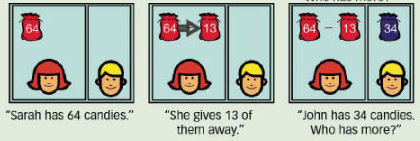Math Naturals
Kindergartners can solve relatively complex addition and subtraction problems if allowed to use their intuitive grasp of approximate quantities.
By Emily Sohn
It’s probably an exaggeration to say that kids are natural math geniuses. But kindergartners can solve math problems with large numbers long before they officially learn how to add and subtract. By using their instincts to estimate values, researchers report, kids can avoid the confusion of exact calculations.
Psychologists from the University of Nottingham in England recently tested kids from a variety of backgrounds to make sure that wealth or level of education didn’t get in the way of their results.
 |
|
In the new study, kids faced approximate-arithmetic problems involving addition, such as this one. |
| Camilla K. Gilmore |
The first study involved 20 5- and 6-year-olds from wealthy, well-educated families. The kids sat in front of computers that showed a series of three-part math problems. One problem, for example, showed a girl’s face in one box and a boy’s face in another box. Above the girl’s face was a bag labeled “21.” Words on the screen read, “Sarah has 21 candies.”
The next screen showed a bag labeled “30” above the girl. Words read, “She gets 30 more.” Finally, a bag marked “34” appeared above the boy. Words read, “John has 34 candies. Who has more?”
Nearly three-quarters of kindergartners got the answer right. If the kids had just guessed who had more candies, only half of them would have been correct.
In a second experiment, the scientists tested 37 kindergartners from poor and middle-class families. The kids had to answer questions in a hallway outside their public school classroom, meaning there were more distractions than in the first study. Still, almost two-thirds of these kids got the answers right.
 |
|
Subtraction problems presented to kids in the study included this one. |
| Camilla K. Gilmore |
In a final experiment, 27 kindergartners from wealthy backgrounds faced a subtraction problem and a comparison problem. Again the text was accompanied by boxes showing girls and boys. Subtraction questions looked like this: “Sarah has 64 candies. She gives 13 of them away. John has 34 candies. Who has more?”
Comparison questions asked things like: “Sarah has 51 candies. Paul has 64 cookies. John has 34 candies. Who has more candies, Sarah or John?”
Again, the young math whizzes came through. They correctly answered two-thirds of the subtraction problems and four-fifths of the comparison problems.
The results of these tests suggest that kids have a natural ability to estimate numbers. Scientists have already observed similar abilities in other animals.
Knowing their students have such math skills might help teachers better teach arithmetic.
“The teachers . . . were skeptical about our experiments,” says lead researcher Camilla K. Gilmore. But in the end, she adds, teachers were “surprised both by their students’ success and by their enjoyment of the tasks.”—Emily Sohn
Going Deeper:
Bower, Bruce. 2007. Take a number: Kids show math insights without instruction. Science News 171(June 2):341-342. Available at http://www.sciencenews.org/articles/20070602/fob6.asp .
Sohn, Emily. 2005. Wired for math. Science News for Kids (Dec. 7). Available at http://www.sciencenewsforkids.org/articles/20051207/Feature1.asp .
______. 2005. Monkeys count. Science News for Kids (July 13). Available at http://www.sciencenewsforkids.org/articles/20050713/Note3.asp .







